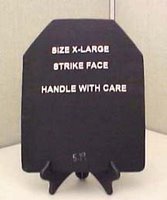
There seems to be a lot of press lately about the Army and Marine's failure to provide side protective inserts for the interceptor body armor. What do the soldiers and marines currently have? What would issuing these inserts provide?
Each soldier or marine receives the outer tactical protective vest with the chest and back inserts. The outer vest is made of a kevlar-like material that provides limited protection against shrapnel and small caliber pistol rounds. The plates that get inserted are made of a hard ceramic. For an earlier version, see the movie Black Hawk Down, where, prior to the mission, one ranger removes his back protective plate (only later to be shot in the back). The plate inserts provide protection for rifle rounds (but not sniper or machine gun rounds).
Army doctrine prior to the invasion separated soldiers into three groups of branches: combat arms, combat support, and combat service support. In a conventional conflict (which Operation Iraqi Freedom was until the insurgency rose), the combat arms branches receive the heaviest armor: tanks, personnel carriers, armored humvees, and the ceramic plates. All other branches received kevlar vests, because the largest threat to them was perceived to be artillery strikes, which kevlar vests have a great record in protecting from shrapnel.
Yet, as soon as the insurgency began, the army and marines pushed interceptor plates to all soldiers as it became clear that every soldier was on the front line.
History teaches us that he who creates a better armor will soon be defeated by a way to beat that armor. Insurgents, realizing that they could no longer shoot a soldier from the front or back and wound him or her, began shifting to soft points: namely the deltoids, shoulders, and side rib cage. Marine studies have shown that approximately 80 marines and soldiers died from such rifle wounds.
The solution? Provide deltoid/shoulder, and side protective inserts. However, what is the cost to the individual solider of adding this additional armor?
Soldiers on foot patrol already carry over 100lbs in their weapon, armor, ammunition, communications, rations, water, navigation equipment, and any other mission-specific requirements. The weight of this additional armor is almost 15-20 lbs extra. For anyone ever to hump several miles, twenty more pounds is incredible. The heat trapped by the armor also poses a problem for soldiers exerting themselves in sprints to cover and in an effort to close with and destroy the enemy. The bulkiness of the armor also cuts into the soldier's flexibility and maneuverability. Again, we are talking about "light" infantry - not tanks.
Nevertheless, the Army and Marines should procure and issue this equipment - which they are. But the issue here is not that the "President refuses to give our troops what they need" but that issuing this armor will not significantly reduce our casualties. I suspect that many commanders will not demand that their soldiers wear a complete interceptor outfit on foot patrols. This armor will be of best use for mounted soldiers (although it will probably just prevent them from ducking down in the hatch or jumping out) or for soldiers on stationary guard. Don't believe that this armor will protect a soldier from an IED, though, because if an IED can destroy an M1 tank, then no amount will protect the infantryman.
As always, the mission and commander will dictate what the solider will bring on patrol.
Its just another non-issue that the MSM and various pols want to make the issue of the day.
No comments:
Post a Comment